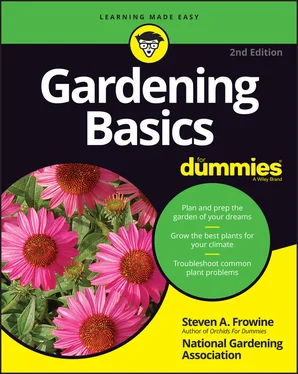Hiring a pro for landscaping help
If you decide to get professional landscaping help, be savvy so you get good work and you get what you pay for. Here are some guidelines:
Before you check online, ask around. Word-of-mouth is an ideal way to get started. Find someone who has done this like a neighbor, a friend, a Facebook friend, or ask at a trusted garden center.
Find a minimum of three possible contractors. They should be willing to make an initial appointment that involves assessing and estimating only; be sure to ask whether they charge for this step (and whether, if you go with them, the fee can be credited to the job).
When the professionals arrive, have some copies of your plans to show and, if need be, hand them over.
Ask for a bid in writing — materials and labor estimates with a clause for addressing unexpected expenses and overruns. To figure out what a reasonable cost would be, ask friends and neighbors what they paid, and get estimates from multiple sources.
Check references. Also confirm that the contractor is both licensed and insured.
Pick someone you like and, more importantly, can communicate with.
Discuss concerns every step of the way — the more communication, the better. If changes come up, be smart and get the revised plans and charges in writing.
Pay in installments — give a deposit, then perhaps pay a second installment or more, and finally pay the last one when all parties agree the work is complete and satisfactory. Such an arrangement gives the contractor security and a commitment from you but also prevents you from being taken for a large fee if something goes awry.
Know what you like. Contractors aren’t mind readers. The more you have figured out what you want ahead of time the more satisfied you’ll be with the final result. What colors do you prefer? How much maintenance do you expect? Do you like any particular roses, flowering trees, flowering shrubs, evergreens, bulbs, and other types of plants?
 Start the process of hiring a contractor early if you can. Winter is an ideal time. Good people have full calendars, and spring commitments are booked early. Finding the right professional, somebody you can afford, or someone nearby may take some time; you may interview several before settling on one.
Start the process of hiring a contractor early if you can. Winter is an ideal time. Good people have full calendars, and spring commitments are booked early. Finding the right professional, somebody you can afford, or someone nearby may take some time; you may interview several before settling on one.
Chapter 3
Getting into the Zone – Your Garden’s Zone
IN THIS CHAPTER
 Deciphering hardiness zones
Deciphering hardiness zones
 Growing in seasonal frost zones
Growing in seasonal frost zones
 Cheating zones and growing seasons
Cheating zones and growing seasons
Newcomers to gardening are often baffled by all the talk of zones in gardening magazines, books, and catalogs, on plant labels, and online. These beginners often hear more-experienced gardeners, garden center staffers, and professional landscapers tossing around zone terms and numbers as well. You may sense that this zone business is some kind of secret code or language that’s hard to remember or tricky to understand. It’s not. It’s really a simple (if generalized) system for describing climate so you can figure out whether a plant ought to be able to grow where you live.
Most plants grow best in roughly the same temperatures and humidity that human beings enjoy, but some plants like it cooler, some warmer. This chapter helps you to know and navigate the zones so you can put the information to use and pick out the right plants as you plan or add to your garden.
Focusing on Location — Different Hardiness Zone Maps for Different Folks
If all that gardeners ever grew were locally adapted plants, you’d have no reason to find out or concern yourself with hardiness zones. But of course, you want it all, right? You want to grow exotic goodies from distant lands or plants from allegedly similar but far-off places.
Indeed, you already do have it all: Peonies come from Asia, tulips hail from Turkey, and strawflowers are from Australia. So after your initial infatuation with a plant that’s new to you, you can ask yourself, “Is growing this in my garden possible?” Finding out the plant’s appropriate zone gives you an answer.
People commonly use hardiness-zone information for trees, shrubs, and perennial plants. Annuals don’t get rated, or just don’t count, because they live for only one growing season, anyway. The same is true for vegetables most of which hail from tropical climates. Hardiness zones are all about survival from one year to the next. (And anything tender grown in a pot can always be moved inside out of the weather, thus avoiding the issue.)
Just to complicate matters, different zone maps are out there, and some are better depending on where you live. The USDA Plant Hardiness Zone Map is the most prevalent one that gardeners in North America use, but others exist. The American Horticultural Society’s Heat-Zone Map is more useful and popular for people in the Southern and Western United States, while Sunset’s Garden Climate Zones Map, though complex, serves the Western states well. Furthermore, Canada also has its own hardiness map (see the Color Insert).
Looking at the world’s plant hardiness zone maps
Every part of the world has its own hardiness zones, and most maps are set up the same way. The USDA Plant Hardiness Zone Map, for example, is a color-coded or shaded map, sometimes accompanied by a chart that expresses the same information. Check out the Color Insert to see this map; you can also see the map (and others) in many places after you become tuned in to it — a poster tacked up on the wall at your local garden center, the back flyleaf of gardening books, in the back pages of most garden magazines, tucked into the interior of your favorite gardening catalog, or online. The map is interactive so you can find your zone by entering your Zip code. You can check this map out at the National Gardening Association NGA) website at https://garden.org/nga/zipzone/ or other online versions of the map, often found on the websites of mail-order seed companies and plant nurseries, which usually are interactive.
The United States Department of Agriculture published, and has occasionally modified and updated, this hardiness zone map of North America. The most recent map, based on climate data gathered at National Weather Service stations throughout the United States and by weather stations throughout Canada and Mexico, came out in 1990 and was updated in 2012. You can find 11 zones marking the average lowest winter temperatures, with Zones 2–10 divided into subzones.
Canada’s plant hardiness zone map, suited for Canada’s colder climate, shows nine zones, based on average climatic conditions and altitude of each area. The harshest zone is 0, and the mildest is 8. In addition, the major zones are further divided into subzones. For example, Zone 4 splits into 4a and 4b, where zone a is slightly colder than zone b. You can see Canada’s map in the Color Insert or online at http://planthardiness.gc.ca/ .
Here are a few other hardiness zone maps that may interest you:
Europe: The Hardiness Zone Map of Europe presents a general overview of the European continent and can be broken down further into each European nation and the zones within it. You can see this map online at www.gardenia.net/guide/european-hardiness-zones . The Royal Horticultural Society (RHS) offers plant hardiness information for United Kingdom. Check this out on their website at www.rhs.org.uk .
Читать дальше

 Start the process of hiring a contractor early if you can. Winter is an ideal time. Good people have full calendars, and spring commitments are booked early. Finding the right professional, somebody you can afford, or someone nearby may take some time; you may interview several before settling on one.
Start the process of hiring a contractor early if you can. Winter is an ideal time. Good people have full calendars, and spring commitments are booked early. Finding the right professional, somebody you can afford, or someone nearby may take some time; you may interview several before settling on one. Deciphering hardiness zones
Deciphering hardiness zones










